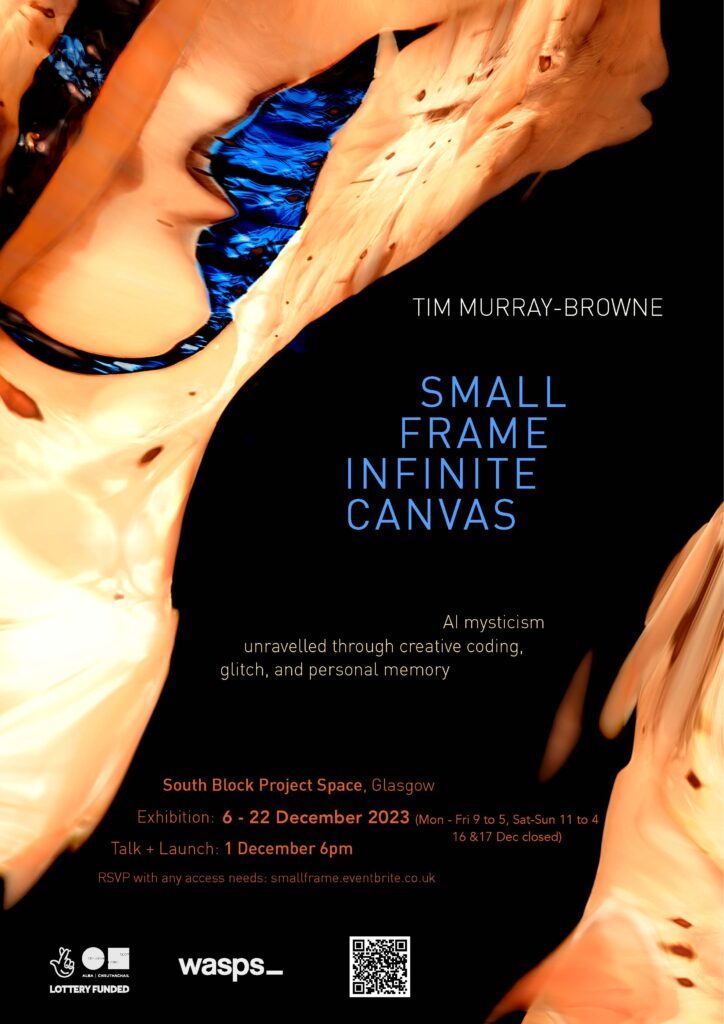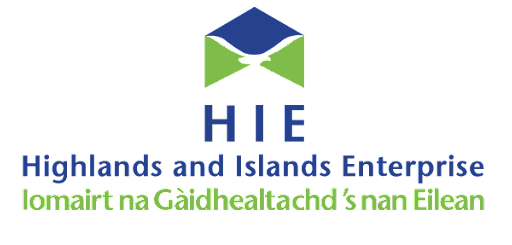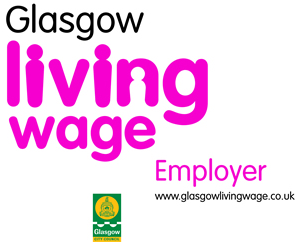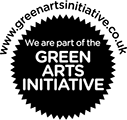Creative Hangouts, led by visual artist Kayleigh McGuinness, is hosting their first ever community exhibition at South Block this month for one day only.
“I had this idea during lockdown to build a safe place for children to embrace their creative curiosity. A place that encouraged self-expression through accessible and playful visual art techniques. I brought this idea to life in October 2022, and since then have been delighted to work within schools and organisations offering a nurturing environment for children to process & express themselves through art. Creative Hangouts has since worked with over 500 children (and counting) to build their confidence and sense of individuality through art making processes” – Kayleigh McGuinness
The exhibition will be made up of work by the children that have participated in the workshops hosted by Creative Hangouts across Glasgow.
Visitors are welcome to stop by the show on Saturday 23 March, 1pm-3pm. The organisers will give a brief thanks to the participants, and there will be a live drawing performance beginning at 1:30pm.
Black intertidal zone inspired textiles and wood artworks symbolising concealed boundaries within self, society and stewardship.
This exhibition crosses boundaries of visual, applied and conceptual art, challenging viewers to reconsider their relationships with themselves, society, and the environment. The work draws inspiration from the black intertidal zone visible on rocks all around the world’s coastlines. This transitional area emerges and recedes with the pulse and rhythm of the tides, the pull of the sun and moon, and becomes a metaphor for the often unseen and overlooked boundaries and forces that shape our individual and collective experiences. ‘Hidden Line’ presents an exploration of these concealed, interconnected boundaries within the domains of self, society, and stewardship. Ultimately, the exhibition seeks to inspire insight, responsibility and mindfulness, challenging viewers to acknowledge and address the divisive hidden lines that may be deflecting attention from our collective psychological wellbeing, social dynamics, and environmental health.
Crafted from wool and wood, the unique, useful artworks featured in this exhibition are worthy of heirloom status. I use the hand tufting technique to paint and sculpt with yarn, weaving in elements of the natural world and heritage motifs. Each work is unique with my practice reminiscent of evolution and each finished product embodies a sense of new life.
The stools are sourced from local storm-fallen trees and crafted in collaboration with skilled woodworker Phil Crennell of The Art Vice. Phil draws inspiration from his materials and constant contact and respect for his place in nature, weaving his craftsmanship seamlessly into the narrative. Our collaboration adds layers of meaning to the works, symbolising the unseen but essential interdependence and symbiosis necessary for the well-being going forward.
In the realm of self, the textiles represent the intricate tapestry of our consciousness, interwoven with threads of personal choices, values, and perspectives. The wood with its organic and structural nature, stands as a metaphor for the innate connection between humanity and the Earth. On a societal level, these artworks highlight the veiled boundaries that enable the perpetuation of practices detrimental to our planet, with a work such as ‘Unravelling’, symbolic of the, often abolished, marks humankind has made over time and are now fraying away the health of our mother nature. The same textile, embodying the patterns of societal norms and expectations, may inadvertently contribute to a collective blindness to environmental concerns. The wood, as a structural element, simultaneously underscores other invisible foundational aspects of societal structures that often turn a blind eye to ecological crises.
These artistic expressions serve as a call to unveil and address the genuine issues surrounding the disregard for our principle mother, Earth, and all life calling this planet; according to the UN up to 1 million plant and animal species are threatened with extinction. In parallel with delving beyond the superficial boundaries depicted in the art, we confront the urgency of recognizing our collective impact on the environment, our vulnerability and overwhelming powerlessness. Simply developing better relationships with self, society, and this Earth that we all share, we will collectively increase lines of connections and holistic health and well-being.
Significantly influenced by a rural upbringing, Laura Derby (Rugaura) chose to obtain a BA Honours Degree in Industrial Design (Woven Textiles) at The Scottish College of Textiles through which her creative appreciation for colour, materials and application could develop. Working as an artisan rug maker in New Zealand inspired Laura to create her own designs and another influence has been the life and work of Friedensreich Hundertwasser; painter, architect, ecology activist and philosopher. A parallel detour into health and social care over the past 25 years has further enriched and shaped Laura’s artistic identity.
Thanks to WASPS, Craft Scotland and The Inches Carr Foundation significant milestones which have steered and informed Laura include residencies at Marchmont Creative Spaces and The Admiral’s House on Skye. Laura exhibits annually through Upland’s Spring Fling Open Studios event and features regularly in group exhibitions in Kirkcudbright. Kirkcudbright National Gallery and Buy Design Gallery in Jedburgh also stock Laura’s work.
Proudly achieving The Galloway and Southern Ayrshire UNESCO Biosphere Certification Mark acknowledges the origin and sustainability of Laura’s work, emphasising her use of 100% British Wool and upcycled local materials. This intentional choice underscores Laura’s commitment to environmental responsibility and her creations to a level of ecological integrity. In essence, Laura’s artistic journey serves as a testament to her innate connection with nature, commitment to sustainability, and the sincere desire to weave a positive thread into the fabric of life through her distinctive hand-tufted creations.
Immersing in nature evokes a sense of freedom/emotion, because landscapes are naturally occurring, and have a way of connecting with us on a deeper level.
From the artist, Cecilia Mann: Exploring my son Darren’s photography of his hillwalking and cycling has been the inspiration of this exhibition. Allowing me to investigate colour, light, structure and listening to his adventures to tell a story through my artwork. Landscapes evolving at their own pace whilst engaging with the seasons, slowly or dramatically, whilst we observe emotionally and with awe. Nature is indeed an artist shaping the mountains and landcapes, texture, shadow, contours with its never ending palette of plants, snow ice, sun, rain and everything that is natural at its fingertips. During my painting of any of the works, although I have not been on those mountains, but have been on some walks, I feel that I am there in the moment and am so absorbed with what I am painting that it becomes real for me, absorbing the atmosphere, emotion and the character of that place. Personally, I prefer not to write to much about the work, but rather leave it to the viewer to read the paintings in their own words, engaging in their own way. Similar to reading a book and then reading the same book with a different perspective each time. We all have a story to tell, which makes the process of discovery and learning an exciting journey.
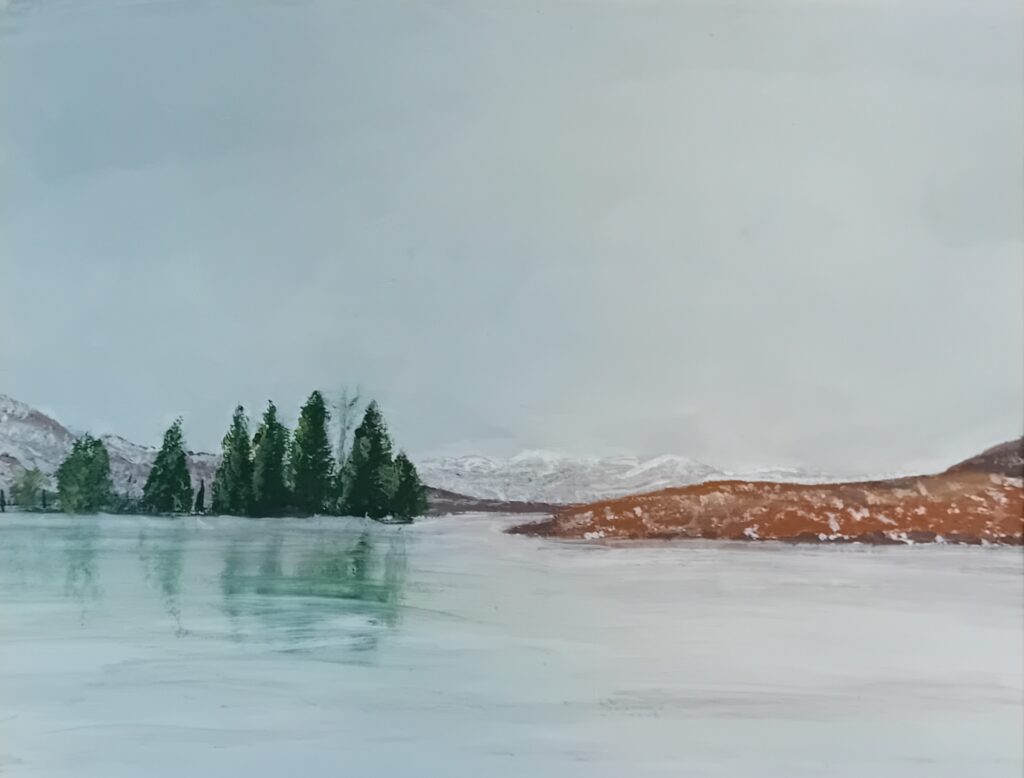
From the artist, Yelena Visemirska: My most recent work is concerned with structures of lines and geometric forms. My main study is based on the invasion of industrial landscapes in natural habitats. During the creative process, I have found myself mostly drawn to the memory of places where I have been and atmospheric experiences that put a mark on my memory. We store and process our responses and thoughts, carrying them through our lives. My goal throughout this investigation of creativity was to gain a better understanding of emerging emotions and feelings towards architectural spaces that filter through my bodily experiences. Close-ups of blocks in urban spaces inform how I compose and layout my paintings. It makes me think about making the marks which represent and interpret part of space occupied by the object abstracting from location and orientation in space, size and other properties such as colour, content and material composition. I use observational photography, searching for the right tone of colours through the lens on industrial surfaces like stains, rust, and old faded paint. From soft greys, which I saw in concrete payments, I ‘adopted’ bright blue, yellow, red… The combination of contrasting tones of colours and lines brings to my work’s attention. I am working with a selected palate in which colours benefit from one another. I hope I can inspire some people to note something new around themselves. The most important and most meaningful to my work is the process itself. My next step is to look into a relationship between myself and the process of painting.
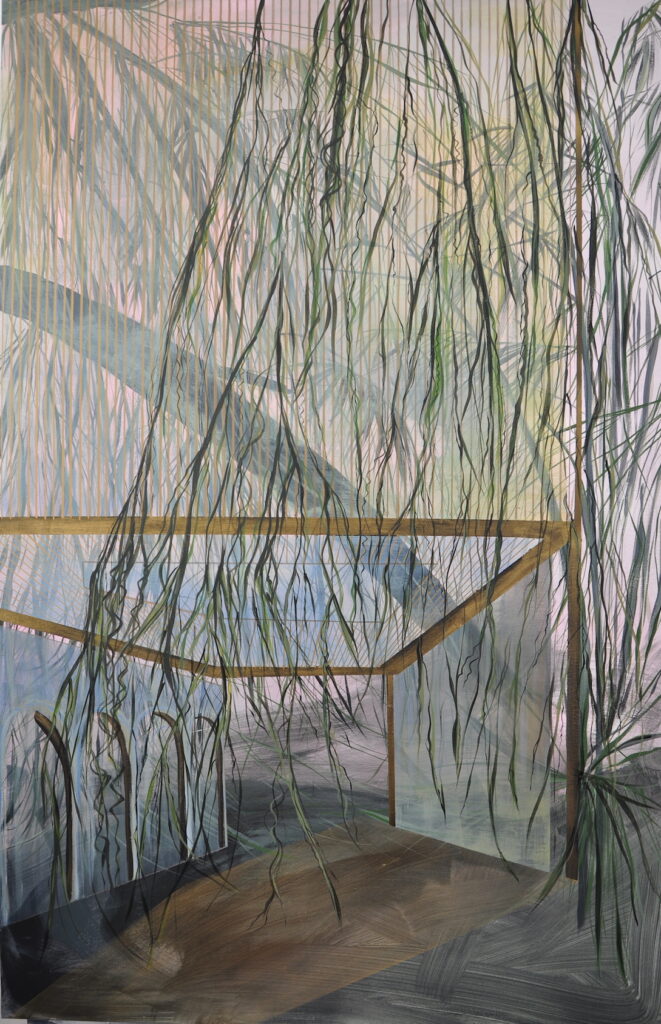
An exhibition of drawings by Janice Deary, inspired by Daoist poetry.
Spring comes and goes,
Deep in fallen flowers and streams.
People are unaware
Of all the immortals around them.
Lü Dongbin
Daoism is the philosophy of Dao, the eternal Way of nature. Daoists encourage a deep respect for the natural world and its cycles of growth and destruction. To become an immortal, one must live in harmony with the Way. Hence, some sages consider plants and animals to be closer to Dao than humans could ever be.
This project emerged out of an encounter with Daoist-inspired poetry. I work in charcoal, an appropriate medium given its connection to the natural cycle. I will also be presenting a short stop-motion animation film, based on a poem by Bai Juyi.
My artistic practice normally begins as an engagement with philosophical ideas, but at a certain point the work seems to take on a life of its own. Creation is a mysterious process: one must constantly be open to new directions and unexpected revelations. I am currently working in charcoal, a stark, prehistoric medium. I enjoy how this crude medium allows me to explore the intersection between brute material mark-making, and the emergence of meaning and beauty.
Originally from South Africa, Janice Deary is now based in Newburgh, Fife. After some time in the academic world (studying and teaching philosophy), Janice decided to pursue an MFA at the University of Dundee in 2020. Since then, Janice has exhibited her work in Scotland and Portugal.
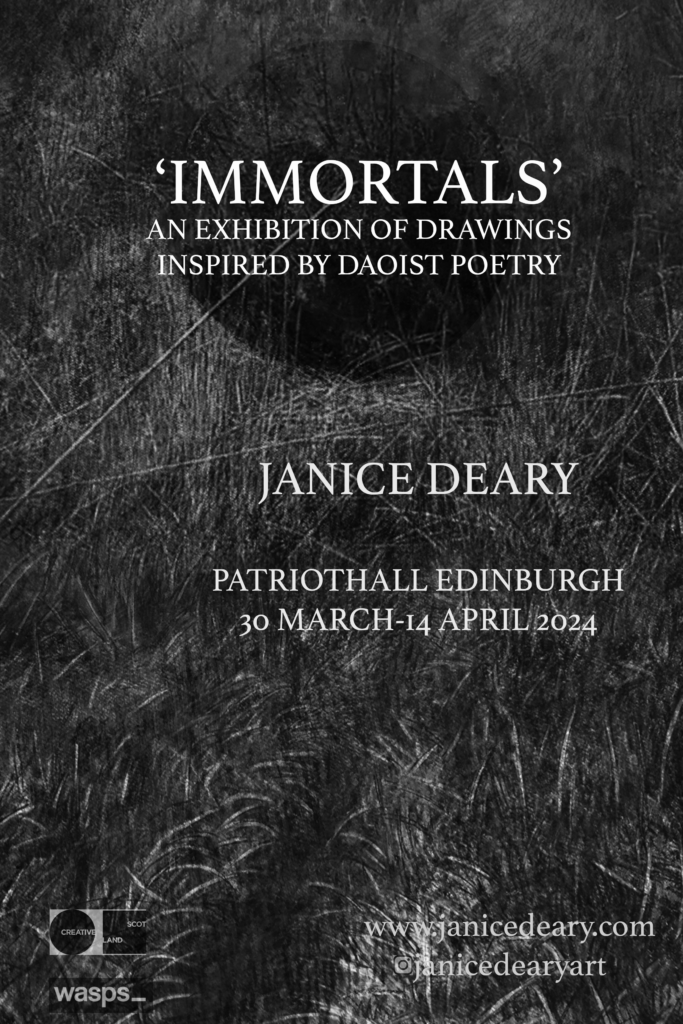
Looking up is the inspiration for this collaborative exhibition of paintings, allowing you to enjoy our ever changing skies without getting a crick in your neck.
The sky above and the large bodies of water on our earth are constantly changing due to the effects of the passage of the sun, the moon and the atmosphere. Visually the sea is in a constant state of flux, its movement reflecting what the sky above is experiencing. This reflection or mirroring, has long been a fascination for living beings. People are in awe of the power and the beauty of these elements.
Both artists talk about how the meditative act of observing these movements feeds their desire to create. Representing in their own ways the effect the changing colours, changing seasons, changing weather and changing times of the day bring to us. Catherine layers up text and asemic writing in her artwork and Stella has a fluid and expressive style, together they will be exhibiting their own perspectives on this ever morphing entity.
The location of the exhibition in Perth as a central point in Scotland is strategically placed as equidistant between the two coast lines: a meeting place. Sargeant’s influence is mainly from the West coast and Auchinleck’s from the East. Both artists are based in Patriothall studios in Edinburgh. They both graduated from Edinburgh College of Art – Stella in 1983 – followed by a post-grad in Cyprus and subsequent long stint abroad. Catherine was a mature student in 2007 when she was awarded the Wasps new graduate prize. Between them they have exhibited widely throughout the UK and various European countries in solo and group shows. This new venture of a joint exhibition allows them the opportunity to juxtapose large and smaller scale paintings in new and exciting way.
Catherine Sargeant is a visual artist based in Scotland who uses text or asemic writing in her artworks. Creating works in paint, pigment, print and collage, she combines materials and techniques depending on the subject and/or the materials available. Frequently working in series with varying scale. Utilising direct observation of the changing sea and sky along with the long held fascination with text allows exciting combinations, Catherine aims to take these and create works that will simultaneously calm and question the viewer. The text in her works have a certain amount of ambiguity allowing the viewer to add to the story. She has exhibited locally and internationally, in 2023 she exhibited in the Royal Academy Summer Show. Graduating as a mature student from Edinburgh College of Art during its Centenary year in 2007, Catherine became the first recipient of the Wasps’ new graduate award, giving her a studio space in Patriothall where she continues to work. She spends many weeks each year in an old fisherman’s cottage near Gairloch which allows direct observations of the changing sea-loch and the expansive sky which are the starting point for many of her artworks.
Stella Auchinleck was born in Edinburgh and spent her formative years in the East Neuk of Fife. Stella is a visual artist exploring the world around her and personalising it. She works predominantly in oils to articulate her joy of saturated colour and in watercolours to capture quickly changing moments. Stella graduated from the ECA in 1983 and promptly headed to warmer climes thanks to a scholarship. Following a post-grad year in Cyprus, she moved to Turkey where she resided for more than 10 years. It was there that a deep rooted love of the sea, the landscape and culture around her inspired her to record her world in paint. Further travels to the subcontinent and far east deepened her desire to capture moments of the environment she finds herself in. By focusing on the shifting patterns and fluctuations of light, Stella seeks to represent vibrant juxtapositions with simplified blocks of strong colour. Years later Stella is established back in Edinburgh and has returned to the coast-line of the Lothians and Fife for her inspiration. The ever changing cloud cover and discrepancies between the quality of light from either shore is a fascination and a recurring theme. Stella looks to traditional sources such as the Scottish Colourists and the American Abstract Expressionists for inspiration. She has been teaching Art and Design in Secondary schools for several years and continues to do alongside her own art practice.
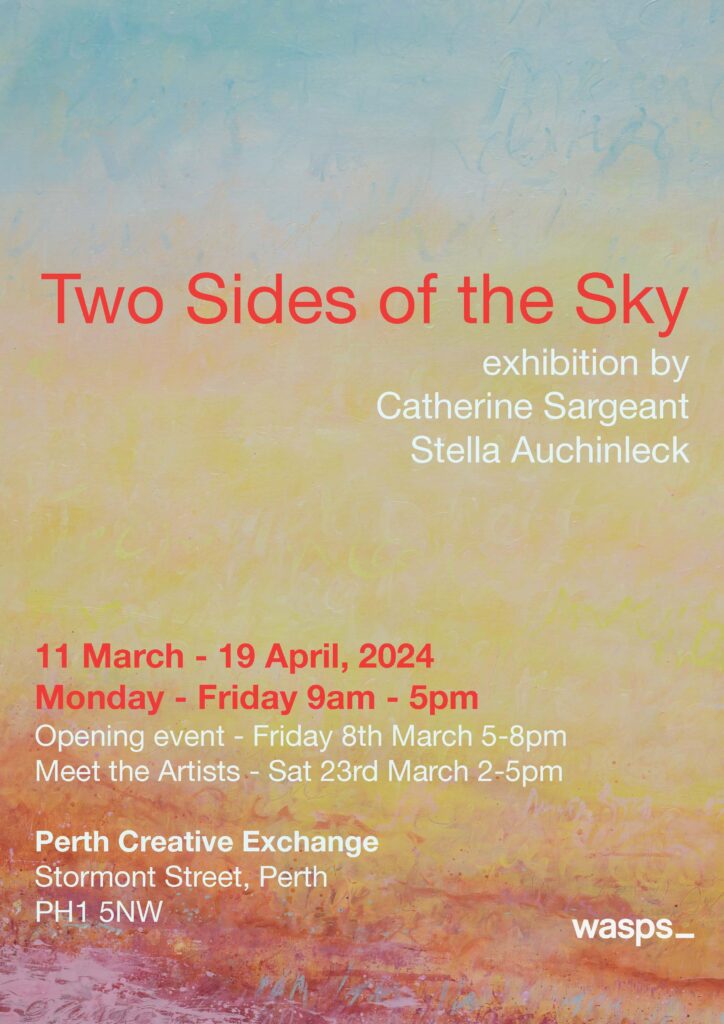
A solo show of sculptural weavings and textile objects responding to themes of place, tool making, memory and repair.
The Time Between The Lights is a solo show by Scottish textile artist Erin McQuarrie. The work was made over the last three years in New York City, Glasgow, and Nairn, in the Scottish Highlands, where McQuarrie now lives and works.
McQuarrie’s sculptural woven pieces sit away from the wall, interacting with light and creating shadow to affect spaces in unexpected ways. Inspired by fragments of colour, light, and the textures of her surroundings, McQuarrie uses the ancient language of warp and weft to capture these fleeting moments.
This show’s work searches for relief from an increasingly digital society that is fueled by rampant consumerism. Made from sourced textile waste, found objects, handspun naturally dyed yarns and unconventional materials, McQuarrie’s weavings challenge the traditional assumption that cloth is a purely domestic medium and demonstrate that textiles can be architectural, dynamic, poetic, and sensitive. Pieces in this show have been inspired by The Glasgow Style movement, the poetry of Sappho, and texts by Virginia Woolf.
Through her practice, McQuarrie seeks ways to explore not only weaving but the tools associated with it. Her prosaic looms are made from waste materials sourced in charity shops, recycling centers, and the natural landscape. These discarded items and waste are deconstructed, reassembled, and collaged together in harmony, producing hybrid tools that act as artifacts of environment and highlight the potential that is all around us. Most importantly, McQuarrie’s work reminds us that there is beauty and importance in the everyday.
Erin McQuarrie is a textile artist and researcher based in the Scottish Highlands. She believes ancient methods of making provide an innovative means of interpreting and responding to contemporary life. Through textiles McQuarrie reacts to the everyday – the language of warp and weft is her vocabulary, providing an antithesis to our fast-paced consumerist society, an outlet to explore health and wellbeing, and a platform for historical recovery.
She completed her MFA in Textiles at Parsons School of Design, NYC (2021) and her BFA in Textiles at The Glasgow School of Art (2018). Her work has been exhibited in Scotland and internationally, including Jane Lombard Gallery, Mana Contemporary, The Royal Scottish Academy, L’Space Gallery, NYPL, and New York Textile Month. McQuarrie was a finalist for The Dorothy Waxman International Textile Prize (2021) and has been awarded a UK/US Fulbright Scholarship (2019/20), NYFA Public Engagement Grant (2021), the Lenore G. Tawney Scholarship at Peters Valley School of Craft (2021), Inches Carr Trust Award Craft Scotland (2022) and Cove Park International Residency (2023).
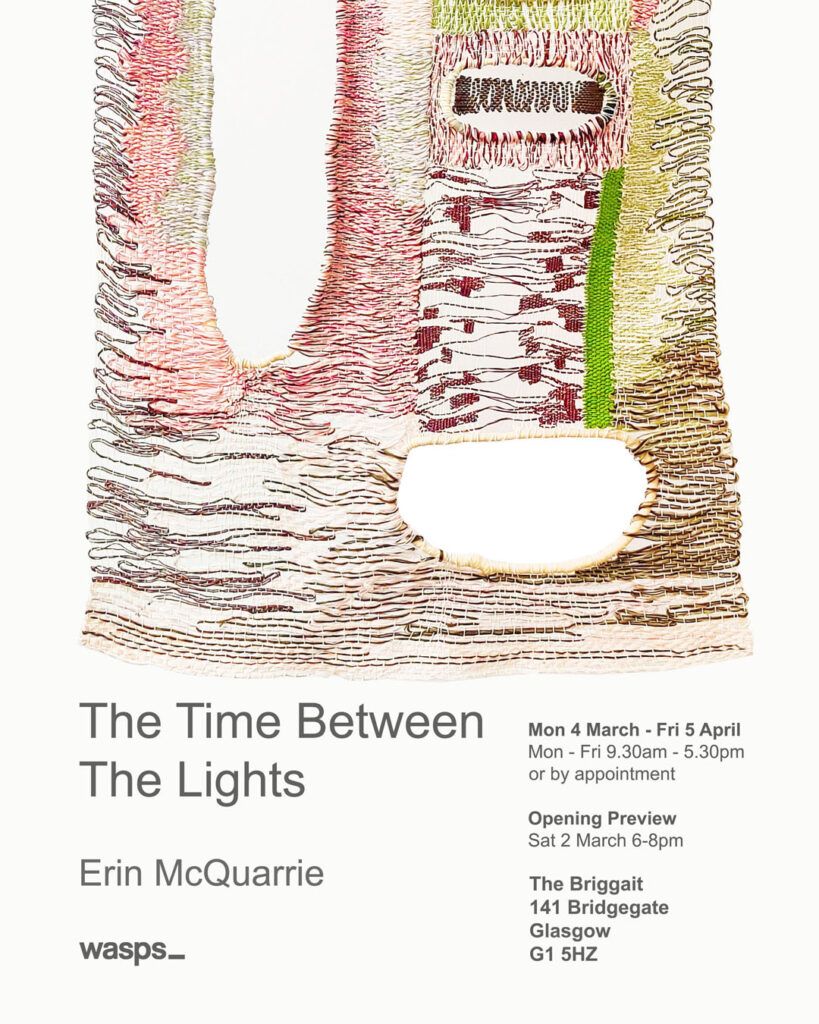
Fill your basket is the latest solo exhibition by artist Louise Evans. New and old paintings are presented together to highlight notions of time and change, dealing with paint as an organic, movable matter.
The processes used to construct these paintings, have become almost ritualistic as the evolving surfaces of paint are formed through acts of concealing, revealing and manipulating the material over long periods of time. Evans uses alternative methods of inscribing and cutting into thick oil paint to reveal and unravel it, piercing with wall nails, cutting with a scalpel or tearing with hands.
These tactile, built surfaces create both tensions and harmony between colours which are heavily layered and manipulated. The constraints of a canvas or wooden cradled board are used as something to defy and push against. This means the paint will often appear as if it is falling off , wrapping around or protruding away from the surface. Evans’ ongoing preoccupation with edges is central to her practice: paint extends beyond the edges of the support – in response to the formal relationships within it – thus enhancing its status as an object. Recent works use additional material built into layers of oil paint such as scrim which aim to create moments of entanglements and mutations of matter within a frame. These processes consider the paintings with corporeal significance, drawing parallels between the body and the painting.
Drawings are used as a way of thinking, to develop form, experiment with material and importantly to play with layers of colour. At times, drawings are made from paintings, used as a way of understanding and reflecting on a more lengthy process.
The paintings are often triggered by observed, lived experiences. They may begin with a specific choice of shape, colour, surface treatment, or material. The work asserts itself as a series of pentimenti: it accrues subsequent layers of paint: each layer and mark affirming the previous one. The paintings emerge as ever-shifting entities, uncovering its own sense of time and history; accounting for a lived experience.
Louise Evans’ paintings explore ideas of marking time, actions and events through a succession of visual considerations and process-led methods. Evolving surfaces of paint are formed in an act of concealing, revealing, and manipulating the material. Oil paint is applied in thick layers forcing the activity of painting to slow down and allow the paint to dry. In the final stages, the paintings are often coated with translucent strata of colour, acting as unifying agents. These processes consider the paintings with corporeal significance, drawing parallels between the body and the painting. Evans’ ongoing preoccupation with edges is central to her practice: paint often extends beyond the edges of the support – in response to the formal relationships within it – thus enhancing its status as an object.
The paintings are often triggered by observed experiences. They may then begin with a specific choice of shape, colour, surface treatment, or material. Evans’ work asserts itself as a series of pentimenti: it accrues subsequent layers of paint: each layer and mark affirming the previous one. The paintings emerge as ever-shifting entities, uncovering its own sense of time and history; accounting for a lived experience.
Louise Evans is an artist born in London, living and working in Glasgow. She graduated from Wimbledon College of Art (2012) with a BA in Fine Art Painting and is currently participating on the Turps Banana, Correspondence Course (22-24).

Opening this January 2024, Co-lack-ting is a multi-disciplinary exhibition by visual artists Despoina Isaia and Salli Yule Tsingas, which portrays the duo’s contrasting habits of collecting and assembling in all its forms. Spanning two gallery spaces, Co-lack-ting presents an immersive experience featuring sculpture, collage, painting, and print. It delves into the realm of memory, weaving together elements of fantasy, reality, trauma, and joy.
Isaia and Yule-Tsingas, both established artists with over fifteen years of individual artistic exploration, converge their distinct artistic practices at The Briggait as part of Wasps Studios’ arts programme. Their joint artistic endeavours explore a world of child-like objects and structures, each existing independently yet coalescing to evoke a profound sense of redemption amidst perpetual crisis.
At the core of their work lies the essence of the inner child, resonating with the maternal connection, remaining in a state of flux—a slightly chaotic fantasy allowing for potential metamorphosis.
Isaia shapes her work through traditional female skills of domestic life, the process of making, from hair, skin, to blankets, satin, leather, the cutting, suturing, filling and manipulating of hanging complex organic soft sculptures, shows its value through hardship. The passing of time is laborious and gives satisfaction. Repetition becomes a way in which to process the past, the present and a redemptive future. The evolving result of covering over, bandaging, suturing is healing.
Yule-Tsingas’ approach involves engagement with neglected objects, transforming the unwanted and abject into cherished embodiments of life. Her collection comprises diverse artifacts, from ancient feet to industrial remnants, all speaking eloquently about intricate personal and societal narratives. Through her artistry, she breathes new life into discarded entities, uncovering their hidden voices, charm, and beauty while resonating with the past, present, and an envisaged future.
Co-lack-ting promises a captivating exploration of transformation, resonating with the inner child, embracing the discarded, and redefining the narratives of objects. This exhibition invites art enthusiasts, collectors, and all those seeking an immersive artistic experience to The Briggait, where Isaia and Yule-Tsingas’ visionary collaboration awaits.
Born in Athens, Greece, Despoina Isaia graduated with a BA from the Athens School of Fine Art, with her final work shortlisted for the first Metro Prize (1999) awarded by The DESTE Foundation. Isaia shapes her work through traditional female skills of domestic life, with a distinct duality, which a soft passive outer shell covers a detachment from self which allows the distance that is needed to process the unsaid, “an unknown proximity to trauma”.
Isaia’s work has been shown by Els Hanappe Underground, Athens at the Armory, New York, and chosen by collector D. Daskapopoulous to feature alongside artworks by Lynda Benglis, Marina Abramovic and Louise Bourgeois at Whitechapel Gallery.
Salli Yule-Tsingas is a British/Canadian artist awarded an MA from The School of Art, Architecture and Design, in London (2014) and was awarded the Owen Rowley Award (2009). Her expansive multidisciplinary practice evolves across painting, collage, sculpture, found objects and installation, united by a consistent playful visual language, seeking redemptive possibilities.
The work is comprised of three strands, the complete, the unfinished/finished and the in-flux: an evolving body of work as a metaphor of a human body in relation to other bodies and places. It refers to far reaching vernaculars of psychology, popular science, momentous displacements, DIY, psycho-geography and anthropology, commingling with joy and desire for a shared life. References include Ilya Kabakov, Isa Genzken, Bill Woodrow, Anna Maria Maiolino and Sarah Lucas amongst others.
Yule-Tsingas is working on her upcoming solo exhibition in Athens in 2024. Recent solo exhibitions include Decoys +, South Block, Glasgow (2023); Gesture Survival, Mt. Florida Studios, Glasgow (2021); Hito’s Forest ‘A Thing like You and Me’ ,101 Gallery, Edinburgh Art Festival (2018) and Circus of Events, Ex Parliament of Modern Greece, Nafplio, (2017). Recent group exhibitions include 1876, The Briggait, Glasgow (2023); Your Safety Our Concern, Morley Gallery, London, (2022) and gefühlt-gesehen-gefunden, The Orangerie, Munich, (2020).
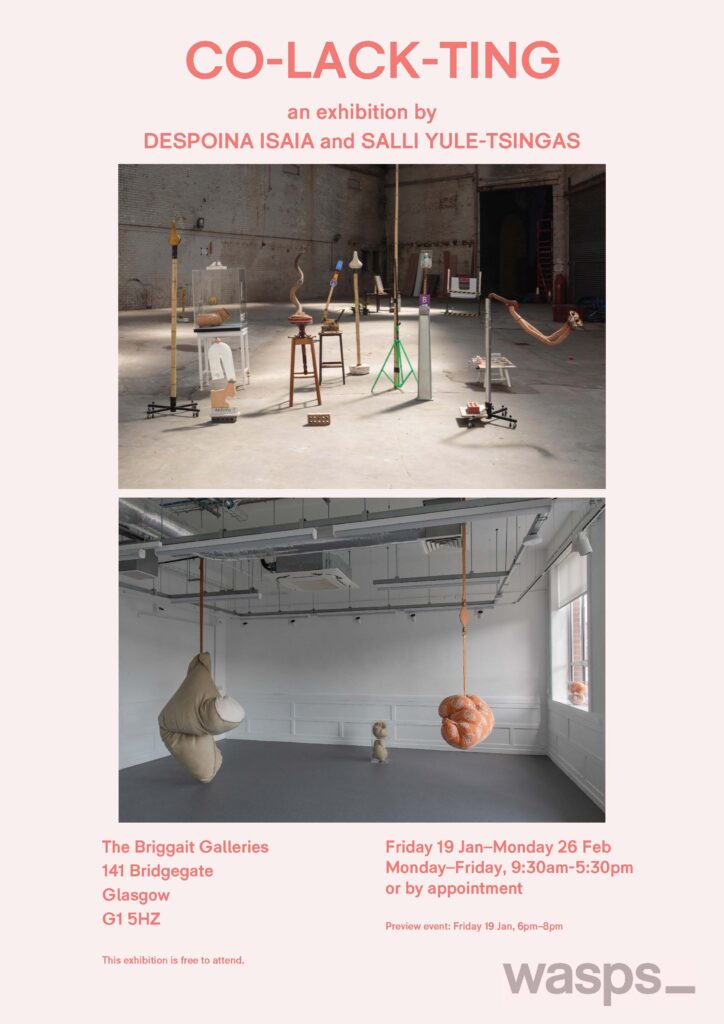
Suppose the world doesn’t revolve round we humans? Maybe we’re just part of a network of relationships, between almost anything – even washed-up seaweed?
My work explores the ‘chain of connection by which all natural forces are linked together and made mutually dependent upon each other,’ an idea which was first mooted by scientist, explorer, naturalist, Alexander Humboldt (1769-1859).
If we accept that we are not separate to the workings of the planet but are deeply entangled then our relationship with the world around us shifts.
I combine copper-covered seaweeds, dried kelp stipes, beach finds and mirror in an intricate dance of contrasting materials and dynamic forms. Like dancers, these entanglements create a new unity. To dance with the natural world by not only taking from it but also giving back to it, offers a possibility of collaborative survival in the face of accelerated change.
References and further reading can be found on Cally’s website here.
Seaweed Craft Workshops
Make your own 2D seaweed artwork with guidance from Cally Nurse at Perth Creative Exchange on Tuesday 13 February. Sessions are at 9:30am-12pm and 1pm-3:30pm. One session is £30 or £50 for both. Email callynurse@gmail.com to book.
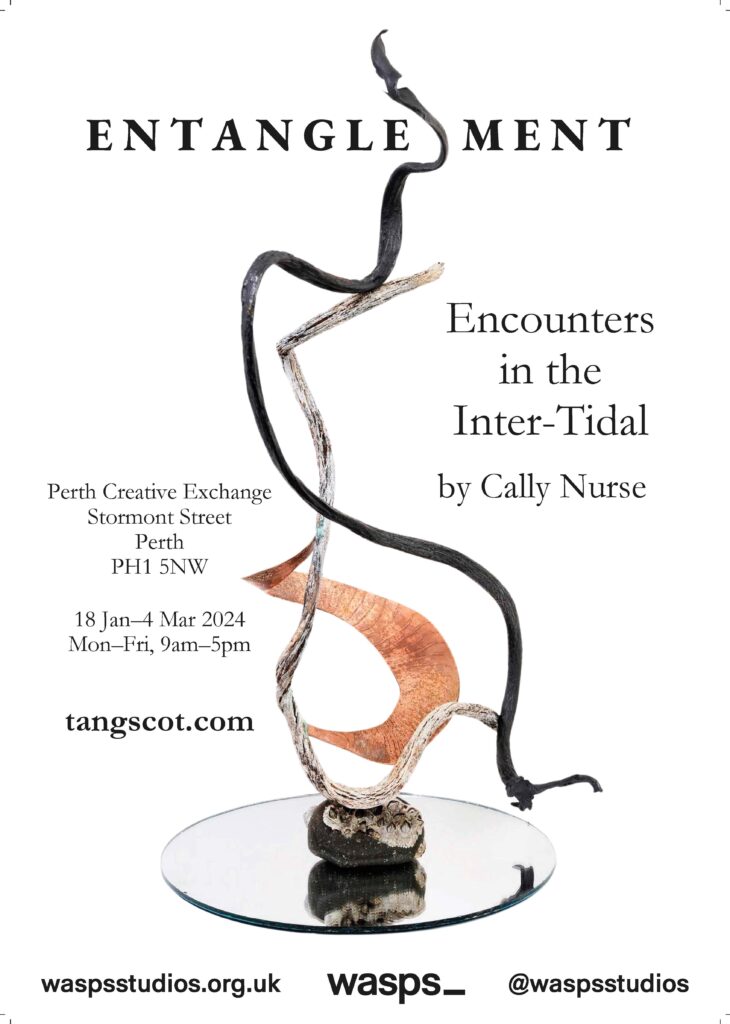
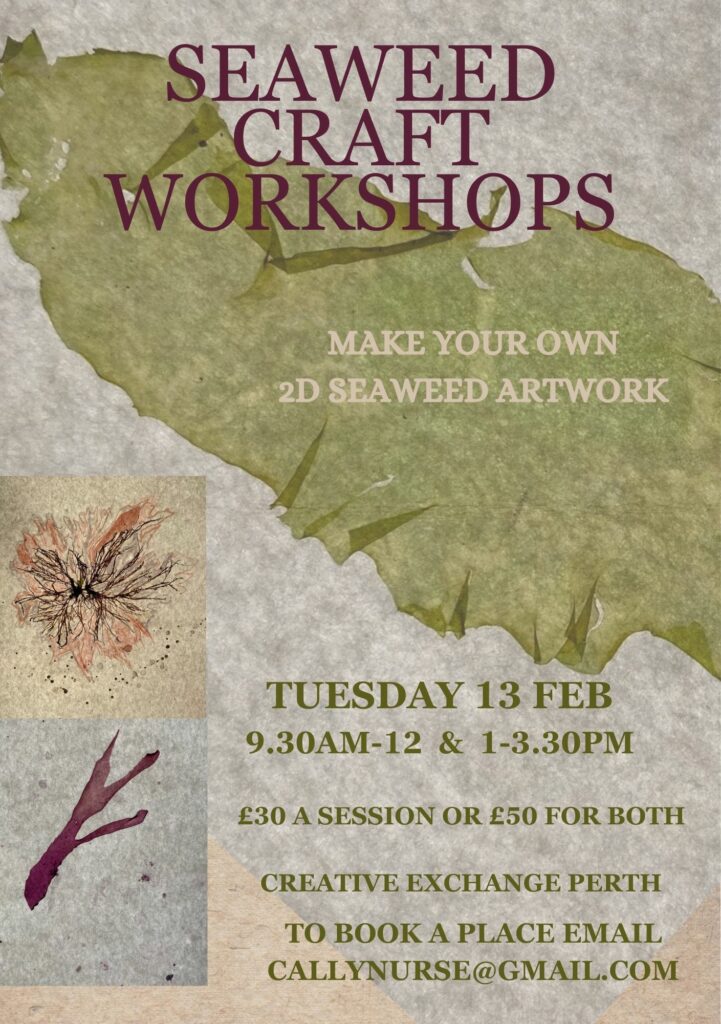
Digital artist and coder Tim Murray-Browne reworks AI through glitch, coding, mysticism and personal memory in an exhibition of new work.
The invitation to the preview of this exhibition on Friday 1 December is open to all. Please RSVP here.
SMALL FRAME, INFINITE CANVAS offers an alternative perspective on generative AI through creative coding, glitch and personal memories.
Each image is generated from a single customised AI. I trained the AI to imagine new memories based on my lifetime archive of 25,000 photos. It has only seen what I myself saw at one point and felt moved to record. The images it generates echo my visual world: Scottish landscapes, tree branches criss-crossing under the sky, rock textures from Cornish beaches and the contours of the human body. (I excluded photos of other people’s faces, but kept many close up studies of the human body.)
Yet my photo archives are a more diverse range of images than this AI was designed to handle. It struggles to make its creations ‘lifelike’. Artefacts appear revealing its own endless world of algorithmic creation.
I modified the AI to expand its frame, creating ever larger images that bring these hidden glitches to the foreground. Each image here contains a small square frame near its centre. As we move away from that optimised frame, the image disintegrates into an endless canvas of offcuts and mathematical building blocks.
Our relationship with AI is still fluid. In my mind, it jostles for contradictory roles: a tool, a collaborator, a pathological copycat, a new kind of mind – sometimes all these at once. The technology is racing ahead faster than my intuitions can.
A common approach to training AI is to harvest huge amounts of images off the web, aiming for a monolithic AI. When I began researching AI in 2018, I felt a strong instinct to train my own system using my own data in the safety of my own PC. If we all express ourselves through the same systems handed down from above, we will surely all find the same paths and end up saying the same things. I needed a way to make it my own, to fuse its world with mine.
In 2021, I stepped back from the overwhelming stream of new AI systems to dig deeper into what’s possible with this single AI I trained. In the years since, I’ve developed a relationship with it. As with many AIs, at first everything is overwhelmingly magnetic. Then it all starts looking the same. But then, after some time, some things emerge that resonate more deeply.
In making the leap to the physical world, I wanted to embrace the scale of the images. They combine detail and scale in a way that can be lost in the fluidity of digital display.
SMALL FRAME, INFINITE CANVAS was created with support from Creative Scotland awarding funds from the National Lottery, Wasps Studios and Preverbal Studio. The AI used to create these images is based on StyleGAN3, created by Nvidia.
Tim Murray-Browne is an award-winning digital artist, creative coder and AI engineer based in Glasgow. His work connects AI, dance, image and sound to explore how we are shaped by technology, and how we might build it differently. It includes creating AI systems that translate dance into sound, an ensemble of new musical instruments that is played entirely by its audience, interactive audio-visual sculptures and live performances with real-time AI.
Tim holds a Masters in Maths and Computer Science from Oxford University and a PhD in Electronic Engineering from Queen Mary, University of London. His work has been awarded the Sonic Arts Prize, nominated for the Ars Electronica STARTS Prize and shown at venues including Tate Modern (London), Victoria & Albert Museum (London), Centre for Contemporary Arts (Glasgow) and Leonardo da Vinci Museum of Science and Technology (Milan).
STATEMENT
My work explores the parts of being human that gets left behind when we interact with technology.
An interactive system constructs a world. It defines not only what you experience but what actions you can take and what consequences ensue. **What dynamics of power are implied by an interaction? How does this shape the intuitions and implicit assumptions of our embodied minds?** Most digital interaction today is built around bureaucratic processes of data entry. My work aims to reveal how it could be so different in the future.
My background is in computer science and coding is my primary means of creation. I value this closeness to the craft of technology and what it reveals, while remaining attentive to how it can distort my perspective.
Much of my work speculates on how different our relationship with technology might be. I create interactive works that celebrates the wildness of being human and amplifies our capacity for empathy, compassion and self-organisation. I also create technology that exposes its own problematic nature: its tendancy to homogenise human identity, to divorce us from our bodies, to invisibly reinforce power dynamics, to impose discrete structures onto an ambiguous reality, to isolate those who diverge from its norms.
